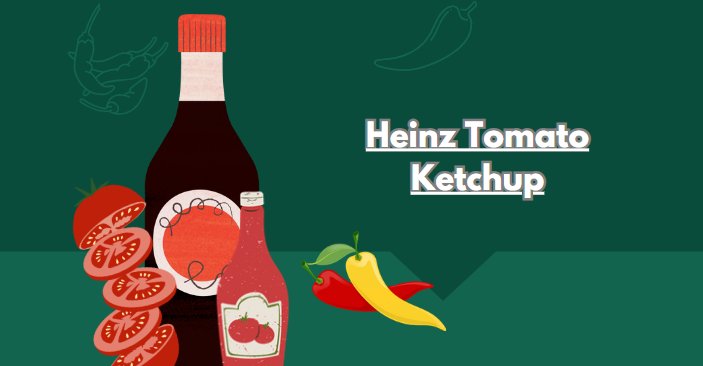Heinz Tomato Ketchup has become synonymous with the condiment category, standing out as a beloved staple in households and restaurants alike. This article explores the history, ingredients, production process, nutritional value, and cultural impact of this iconic sauce.
A Brief History of Heinz Tomato Ketchup
The Origins
Heinz Tomato Ketchup traces its roots back to 1869 when Henry John Heinz and his friend began selling horseradish in glass bottles. The venture blossomed, and by 1876, Heinz introduced his version of tomato ketchup. Unlike many of its contemporaries, which were often made from dubious ingredients, Heinz used ripe tomatoes, sugar, vinegar, and spices, focusing on quality and flavor.
Growth and Popularity
As the years progressed, Heinz’s ketchup gained immense popularity. The brand capitalized on innovative marketing strategies, including catchy slogans and eye-catching advertisements. By the 20th century, Heinz Tomato Ketchup was available across the United States and had begun to spread internationally. Its reputation for quality helped it become a household name, and it remains a top-selling condiment today.
Ingredients: What Makes Heinz Ketchup Unique?
Quality Tomatoes
At the heart of Heinz Tomato Ketchup are the tomatoes themselves. Heinz prides itself on using only high-quality, vine-ripened tomatoes. These tomatoes are harvested at peak ripeness, ensuring a rich, flavorful base for the ketchup.
Sweetness and Tang
Along with tomatoes, the ingredients list includes sugar, distilled vinegar, and a blend of spices. The sugar balances the acidity of the tomatoes and vinegar, creating a harmonious flavor profile that appeals to a broad audience. The specific spice blend is a closely guarded secret, contributing to the unique taste that fans have come to love.
Preservatives and Additives
Heinz Tomato Ketchup is known for being free from artificial preservatives, which appeals to health-conscious consumers. The company maintains a commitment to natural ingredients, ensuring that their ketchup is not only tasty but also aligns with modern dietary preferences.
Also Read : VyvyManga
The Production Process
Harvesting
The journey of Heinz Tomato Ketchup begins with tomato harvesting. The company works closely with farmers to ensure that only the best tomatoes are selected. These tomatoes are typically harvested during peak season, ensuring optimal flavor.
Cooking and Mixing
Once harvested, the tomatoes are washed and processed. They are cooked down to concentrate their flavors before being mixed with the other ingredients. The cooking process is crucial as it enhances the ketchup’s natural sweetness and allows the flavors to meld together.
Packaging
After the cooking process, the ketchup is cooled and packaged. Heinz employs advanced technology to ensure that the ketchup maintains its freshness and flavor. The iconic glass bottle or squeeze bottle packaging allows consumers to easily dispense the condiment while keeping it protected from contamination.
Nutritional Value of Heinz Tomato Ketchup
Caloric Content
Heinz Tomato Ketchup is relatively low in calories, with about 15 calories per tablespoon. This makes it a popular choice for those looking to add flavor without a significant calorie burden.
Sugar Content
While it does contain sugar, Heinz has made efforts to reduce the sugar content in some of its products. Consumers can choose from various options, including organic and reduced-sugar versions, catering to different dietary needs.
Vitamins and Minerals
Heinz Tomato Ketchup contains small amounts of vitamins and minerals, such as vitamin C and potassium, thanks to its tomato base. However, it is essential to consume ketchup in moderation, as the primary appeal lies in its flavor rather than its nutritional value.
Cultural Impact
A Global Favorite
Heinz Tomato Ketchup has transcended borders, becoming a staple in various cuisines worldwide. From burgers and fries to Asian dishes, the versatility of ketchup allows it to complement a wide range of flavors. Its global appeal is evident, as different countries have adopted it into their culinary traditions.
Marketing Innovations
Heinz has consistently been at the forefront of marketing innovation. The brand’s memorable advertisements, catchy slogans, and clever social media campaigns have contributed to its enduring popularity. Campaigns like “Heinz Ketchup is a Must” resonate with consumers, reinforcing the idea that ketchup is an essential condiment.
The Ketchup Controversy
Despite its popularity, Heinz Tomato Ketchup has not been without controversy. Some health advocates criticize its sugar content and have urged consumers to seek healthier alternatives. The debate over ketchup’s role in healthy eating continues, with many consumers seeking brands that align with their dietary choices.
Conclusion
Heinz Tomato Ketchup is more than just a condiment; it’s a cultural phenomenon that has stood the test of time. From its humble beginnings to its status as a global favorite, Heinz has maintained a commitment to quality, flavor, and innovation. Whether enjoyed at a backyard barbecue or as a staple on dining tables worldwide, Heinz Tomato Ketchup remains a beloved addition to meals, proving that some classics truly never go out of style.
With its rich history, unique flavor profile, and cultural significance, Heinz Tomato Ketchup continues to be a staple in kitchens everywhere, making it a true icon in the world of condiments.


